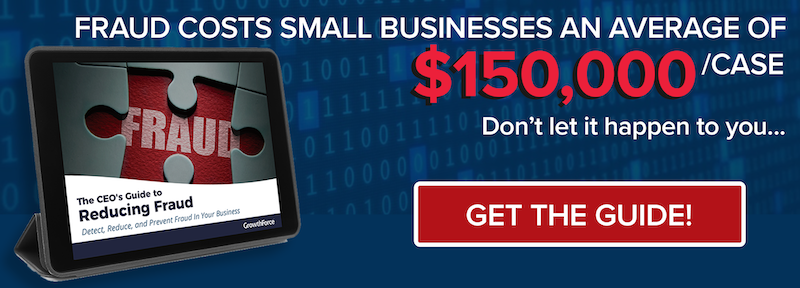
Check Tampering - $158,000 Median Loss Per Case
Check tampering occurs when an employee steals, alters, or forges a check that’s payable from the employer’s business account. Easy access to the business checking account and blank checks make this an appealing form of occupational fraud for an opportunist in search of quick cash.
It amounts to 20.1 percent of fraud cases in small businesses compared to only 8.4 percent in larger businesses.
There are several methods of check tampering. On altered checks, the name of the payee is changed to that of the fraudster, who then misappropriates the funds. On forged checks, the signature of the authorized signer or payee endorsement is forged.
Concealed checks are fraudulent checks that are submitted in a batch so the authorized signer doesn’t notice any irregularity and signs anyway. Finally, in what’s known as an “authorized maker” scheme, a fraudster is authorized to sign checks for the company. When he or she also has access to the company’s checks, misappropriating funds is simple.
Four Check Tampering Schemes:
- Altered Checks – changes the payee to misappropriate the funds
- Forged Checks – forges signature or the payee endorsement
- Concealed Checks – submits fraudulent check for signature in a batch, and authorized signer neglectfully signs and returns
- Authorize Maker – authorized check signer also has access to checks, and misappropriates funds
Here's one example of a common Check Fraud Scenario...
An IT company had a bookkeeper whose husband lost his job. This landed the couple in a short-term cash crunch, and they were unable to pay their AT&T phone bill. The bookkeeper was authorized to write checks on her employer’s behalf, so it was easy to write out a check to the phone company and code it to telephone expenses in the books.
Fortunately, our second set of eyes realized the expense was higher than usual; plus, AT&T wasn’t the client’s telephone vendor. We called AT&T to determine what account the payment was for. Of course, this immediately revealed that the bookkeeper had used company funds for her own purposes. She was immediately escorted out of the building, and the client had the locks to the premises changed.
Outsmart Fraud with Internal Controls
To combat tampering, check cutting and preparation duties must be separated from check signing responsibilities. It’s also imperative that an independent eye, like the owner, manager or outsourced controller, review statements for discrepancies before remitting to the bookkeeper. Businesses should consider outsourcing bank reconciliation if staffing restrictions prevent acceptable separation of duties.
- Owner/manager reviews unopened bank statement, electronic payments and cancelled checks for authorized payee, signature
- Set up bank accounts for daily transaction download
- Compare payee in accounting system to checks
- Restrict access – data entry staff should not reconcile bank statement
- Switch to electronic checks and/or limit access to paper check
- Rotate employee responsibilities and perform audits
- Review audit trail report for changed payee
- Review budget vs. actual report for unexpected expenses
- Set up positive pay and ACH filters
Implementing separation of duties within your check cutting and preparation duties can deter employee check tampering within your organization. However, no system of fraud prevention can rely on trust alone, so if your business does not have the internal resources to maintain separation of duties, you can minimize your risk by outsourcing elements of your bill payment process. We will continue this blog series with additional checklists on how to handle the most common forms of embezzlement and occupational fraud.
For more on different types of occupational Fraud, read on...
The most frequently occurring type of fraud in small businesses is billing fraud, which amounts to 27.1 percent of all cases. Read on about How to Prevent Billing Fraud
Payroll fraud accounts for only 8.5 percent of cases, but the median loss per case amounts to $90,000. Because the amounts are so great, payroll fraud warrants special attention. Read on about How to Prevent Payroll Fraud
Statistical Source: ACFE 2016 Report to the Nations on Occupational Fraud and Abuse ( http://www.acfe.com)

.png?width=563&height=144&name=New%20GF%20Logo%20(37).png)

